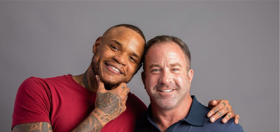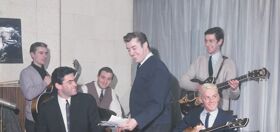
Ed. note: Today’s installment of America’s Queer Liberty picks up where yesterday’s left off…
The Christian right lost some steam in the mid-to-late 1980s. Ronald Reagan his successor, George H. Bush, vowed to uphold America’s traditional values. Like so many politicians, however, the Republican presidents forgot their campaign promises: a move that pushed many Evangelicals out of political life. A. James Reichley elaborates:
Both Reagan and Bush in office, however, concentrated more on economic and foreign policy goals than on the social changes, such as limitations on abortion and restoration of school prayer, particularly sought by evangelicals. Doctrinal differences between fundamentalists and pentecostalists, and personal rivalries among strong will preachers, undermined political unity. Robertson’s candidacy for the Republican presidential nomination in 1988 failed to win the support of even a majority of evangelicals. In 1989, Falwell, facing falling membership and declining contributions, disbanded the Moral Majority.
The rank-and-file may have given up hope, but die-hard religionists were just getting started.
As Falwell, Robertson and the rest licked their wounds, gay activists kept chugging along. The Task Force nabbed federal dollars for AIDS outreach and set out to curb gay-on-gay domestic violence through the Anti-Violence Project, which still exists today. HRC, meanwhile, focussed its energies on the political front. During its first year alone, HRC helped Oregonian representative Jim Weaver defeat his Moral Majority-endorsed opponent. Not bad for an organization that hadn’t even registered as a non-profit. As President Bush’s tenure came to an end, HRC and the Task Force both backed Democratic leaders, namely Bill Clinton. The Republicans made it clear they would never support gay rights. As we’ve seen, America’s plurality voting leaves few choices. Thus, gay groups tactically coordinated their efforts to usher in the Democratic president. HRC offers their official perspective:
[We] reorganized in 1989 to become a membership organization with a connected political action committee…In 1992, HRCF endorsed a presidential candidate for the first time. That candidate, Arkansas Gov. Bill Clinton, went on to win the election – after GLBT voters contributed $3 million to Clinton’s campaign and voted in a bloc for first time, giving him his 5 percent margin of victory.
Gays can’t take all the credit for Clinton’s inauguration, of course, but our involvement showed that we weren’t only here and queer, we had power. The right was furious, but remained faithful to their cause: political domination.
How about we take this to the next level?
Our newsletter is like a refreshing cocktail (or mocktail) of LGBTQ+ entertainment and pop culture, served up with a side of eye-candy.
Following the Moral Majority’s demise (and his failed bid for the Republican presidential nomination), Pat Robertson began pulling his religious resources to establish the Christian Coalition. Though most people cite the Christian Coalition’s birth as 1989, records indicate Robertson registered his Christian Coaltion in 1987, presumably in anticipation of a presidential win. With his high hopes shattered, Robertson decided to take back the movement. Enlisting Ralph Reed’s help, Robertson mobilized millions of voters. They weren’t however, gunning for the Oval Office. They wanted Main Street, America. And all of it.
Speaking to The Denver Post in 1992, “Robertson made no secret of his mission: We want…as soon as possible to see a majority of the Republican Party in the hands of pro-family Christians.” He and his used every media available – print, video, televised – to get their point across. Like a demon in the night, The Christian Coalition crept under America’s radar, feeding tens of millions of people their blasphemous agenda. By the 1994 election, when Republicans swept Congress, the Christian right had distributed over 40 million issues of the “Family Values Voter’s Guide” throughout 100,000 churches. By comparison, the Task Force only had about 35,000 members. So, how did the right get their evil plan off the ground? They started, where else, at the bottom.
Reagan and Bush taught values voters a lesson: the presidency did not stand for their “Christian” rights. Sure, Reagan and Bush espoused Christian rhetoric, but their policy fell flat. Thus, Robertson and Reed decided to target local, vulnerable offices. In this way, they coalesced a foundation for their nationally-minded politics. Former Republican chairman Craig Berkman once told The Nation‘s Greg Goldin:
They have acquired a very detailed and accurate understanding of how political parties are organized. Parties are very susceptible to being taken over by ideologues because lower party offices have no appeal to the vast majority of our citizenry. Many precincts are represented by no one. If you decide all of a sudden because it’s your Christian duty to become a precinct representative, you only need a few votes to get elected. Increasingly, they have the key say so on who will be a delegate at the national convention, and who will write the party platform and nominate the presidential candidate… That’s how they achieve their objectives.
By winning key offices – and mindless minds – the Christian Coalition successfully secured the GOP’s local power base. With their loyalists in place, the right waged a war on Congress and won. In 1994, after Bill Clinton had settled into his first term, the Republicans gained 54-seats in the House of Representatives and picked up eight more in the Senate. The Grand Old Party controlled Congress for the first time since 1952.
The right’s political influence would be felt across the entire nation. Nationally speaking, the conservatives successfully blocked the 1996 HRC-endorsed Employment Non-Discrimination Act. They also helped pass the Defense of Marriage Act, which prohibits the government from forcing gay marriage upon states. (Thanks, federalism.) That same year, in the Evangelical epicenter called Colorado, Bible-thumping politicians put a virulently anti-gay amendment on the ballot: Amendment 2. In order to “protect” their rights, Colorado’s citizens voted to ban any organization from “protecting” gay people’s civil rights:
Neither the state of Colorado, through any of its branches or departments, nor any of its agencies, political subdivisions, municipalities or school districts, shall enact, adopt or enforce any statute, regulation, ordinance or policy whereby homosexual, lesbian or bisexual orientation, conduct, practices or relationships shall constitute or otherwise be the basis of, or entitle any person or class of persons to have or claim any minority status, quota preferences, protected status or claim of discrimination.
Once passed, the amendment effectively prohibited any pro-gay legislation.
Activists balked at the decidedly un-American amendment. Gay rights groups, primarily Lambda Legal, took Colorado to court. And, on May 26th, 1996, the United States Supreme Court ruled Amendment 2 to be unconstitutional. The right lost that battle (which we’ll explore in greater detail next week), but they continued to wage war on America’s liberal democracy when they backed George W. Bush, our current president. Though gay groups crowded around Gore and Kerry in the 2000 and 2004 elections, the Christian right proved to be too effective. And, even worse, more religious cliques hopped on the crazy train. Reichley explains: “The electoral behavior of religious groups during the 1990’s moved away from divisions along denominational lines, and toward divisions within denominations based on religious practice and belief.” Over 40 million religious voters aligned with the Democrats. HRC and the Task Force, meanwhile, had less than one million members. They were obviously no match for the right, who saw no choice but George Bush for their 2000 vote.
Our tactics changed over the years, too, with more direct mailings, fund raisers and electoral literature. Gay rights groups were more determined than ever to take back the American government. And, little by little, we did. In 2004, gay groups successfully fought against the Federal Marriage Amendment, which would have banned same-sex nuptials. Then, over the past three years, we helped Democrats take back local offices and, last November, Congress. You see, like the Christian right, the gay “left” know we have little wiggle room. We can vote for Republicans, who have proven they wouldn’t vote for us, or we can vote for Democrats, many of whom put gay rights front and center. Despite the dozens of other American political parties, informed, reasonably intelligent voters know their vote will only count if it goes toward either the Republicans or the Democrats. Most gay votes have been going to the Democrats, but they’re not necessarily counting.
Despite having a relatively gay-friendly Congress on our side, gay activists and their allies still can’t pass necessary legislation. Why? Veto power, baby. Just two weeks ago, President Bush vowed to veto hate crime legislation. With a Democratic congress and a Republican president, there’s little chance gay rights legislation will become law.
Even if we conquer local offices, Congress and win American hearts, there’s still one obstacle to overcoming America’s Queer Liberty: the American presidency and its at times troublesome judicial connections.



















Comments are closed.